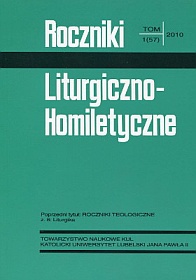The Eucharistic-Paschal Identity of the Liturgical Year
Abstract
The issue of the Eucharistic-Paschal identity of the liturgical year is first of all concerned with the focusing and propagating role of the Easter Triduum in the liturgical year, the message about the mystery of the Lord’s Birth, the message of Mariology and hagiology in the liturgical year and with the cycle of the liturgical year. (1) The focusing and propagating role of the Easter Triduum touches the very foundations of the identity of the liturgical year. This means that the Easter Triduum concentrates on itself the periods, celebrations, feasts, remembrances and ordinary days of the liturgical year. However, at the same time the seasons, celebrations and feasts, remembrances, and ordinary days propagate the mystery of Redemption in the cycle of the liturgical year. This role is rendered by the terms contained in the General Instruction of the Roman Missal, like: making the mysteries of Redemption present, or the cycle of the year. It seems that in the perspective of the liturgical year first of all celebrations like: the feast of the Most Holy Trinity, of Christ’s Most Holy Body and Blood, of the Sacred Heart of Jesus, of Jesus Christ King of the Universe, etc. receive their identity. (2) The mystery of the Lord’s Birth in the whole of the liturgical year is referred to first of all by the celebrations, feasts and remembrances of Blessed Virgin Mary. For many of them the celebrations of the Immaculate Conception of Blessed Virgin Mary or of the Annunciation of the Lord become a kind of bridge to the mystery of the Lord’s Birth, or indeed to the Easter Triduum. This especially concerns the remembrances connected with the spirituality of religious orders or the appearances of Blessed Virgin Mary. Among celebrations, feasts and remembrances of the Lord’s Saints the feast of the Holy Archangels, the celebration and remembrance of St Joseph, the feast of the Saint Evangelists, the Doctors of the Church, order-founders, and others, based on their spirituality and teaching, refer to the Lord’s Birth. (3) In the transmission of the Eucharistic-Paschal Mariology and hagiology attention should be first of all paid to the remembrance of Our Lady of the Sorrows, Our Lady the Queen, Our Lady of the Holy Rosary, the feast of the Mother of the Church, as well as to feasts and remembrances of the Saints who were particularly connected to the Paschal Mystery. The proper perspective is also given to Mariology and hagiology by the celebration of the Ascension of Our Lord and of Pentecost. With respect to other groups of Saints, the adequate context may be noticed by the celebrations, feasts and remembrances of the Worshippers of the Holy Eucharist, the Founders of charities, the Mystics of the Lord’s Passion, the Martyrs, the Educationists, the Missionaries, the Worshippers of the Sacred Heart of Jesus, Kings. It is celebrations, feasts and remembrances of Saints that join experiencing the mystery of the Lord’s Birth and the Paschal Mystery. (4) The cycle of the liturgical year is not only a chronological cycle, but also a Paschal one. The cycle is first of all the succession of the Easter Triduum, experiencing the mystery of the Lord’s Birth, and respective periods of deepening and preparation. The mutual succession of celebrations, feasts, and remembrances is first of all concerned with the Paschal mystery, with the Lord’s birth, with Blessed Virgin Mary and with the Apostles. Particular celebrations, feasts and remembrances enrich the cycle of the liturgical year and in a peculiar way reach to the depth of the past of the work of Salvation, and at the same time they look ahead of this work. They reach the creation of the world, go beyond the time of the world, and at the same time they look ahead of eschatology.
References
Barsotti D.: Pascha z Chrystusem. Jak zrozumieć Mszę Świętą. Kraków 2009.
Celebrare per avere parte al mistero di Cristo. La partecipazione alla liturgia. Atti della 59. Settimana Liturgica Nazionale 2008. Roma 2009.
Heider Ch.: Eucharistie erleben und verstehen. Augsburg 2007.
Janicki J.: Eucharystia – paschalna droga chrześcijanina. W: Liturgia domus carissima. Red. A. Durak. Warszawa 1998 s. 57-84.
Jedna wiara – jedna Msza. Od Mszału Piusa V do Mszału Pawła VI. Red. Cz. Krakowiak, B. Migut. Lublin 2009.
Mick L.E.: Eucaristia. Per capire il sacramento. Padova 2008.
Müller G.: Msza święta. Źródło chrześcijańskiego życia. Lublin 2007.
Paternoster M.: Institutio generalis Missalis Romani. Uno studio per conscerla meglio. „Rivista Liturgica” 94:2007 s. 707-713.
Szczepaniec S.: Eucharystia – Ofiara czysta, święta i doskonała. W: Laudate Dominum. Red. K. Konecki. Gniezno 2005 s. 243-251.
Worbs M.: Człowiek w misterium liturgii. Antropologiczny wymiar liturgii w ujęciu Romana Guardiniego. Opole 2007.

